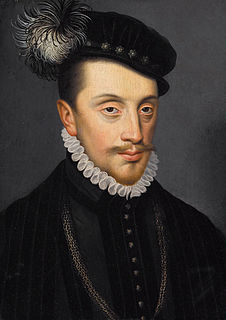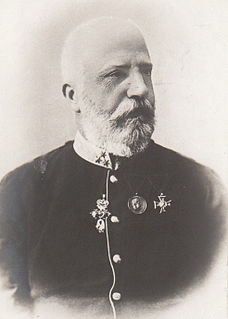
Otto von Habsburg, also known by his traditional royal title of Archduke Otto of Austria, was the last Crown Prince of Austria-Hungary from 1916 until the dissolution of the empire in 1919, a realm which comprised modern-day Austria, Hungary, Bosnia and Herzegovina, Croatia, the Czech Republic, Slovakia, Slovenia, and parts of Italy, Montenegro, Poland, Romania, Serbia and Ukraine. He became the pretender to the former thrones, Head of the House of Habsburg-Lorraine, and Sovereign of the Order of the Golden Fleece in 1922, upon the death of his father. He resigned as Sovereign of the Golden Fleece in 2000 and as head of the Imperial House in 2007.

Ferdinand I was the Emperor of Austria from 1835 until his abdication in 1848. As ruler of Austria, he was also President of the German Confederation, King of Hungary, Croatia and Bohemia, King of Lombardy–Venetia and holder of many other lesser titles.

Archduke Franz Karl Joseph of Austria was a member of the House of Habsburg. He was the father of two emperors: Franz Joseph I of Austria and Maximilian I of Mexico. Through his third son Karl Ludwig, he was the grandfather of Archduke Franz Ferdinand of Austria – whose assassination sparked the hostilities that led to the outbreak of World War I – and the great-grandfather of the last Habsburg emperor Karl I.

Charles III, known as the Great, was Duke of Lorraine from 1545 until his death.

The House of Lorraine originated as a cadet branch of the House of Metz. It inherited the Duchy of Lorraine in 1473 after the death of duke Nicholas I without a male heir. By the marriage of Francis of Lorraine to Maria Theresa in 1736, and with the success in the ensuing War of the Austrian Succession, the House of Lorraine was joined to the House of Habsburg, and was now known as Habsburg-Lorraine. Francis, his sons Joseph II and Leopold II, and grandson Francis II were the last four Holy Roman Emperors from 1745 to the dissolution of the empire in 1806. Habsburg-Lorraine inherited the Habsburg Empire, ruling the Austrian Empire and Austria-Hungary until the dissolution of the monarchy in 1918.

Ferdinand IV, Grand Duke of Tuscany was the last Grand Duke of Tuscany from 1859 to 1860. The House of Habsburg-Lorraine continued to hold the title as pretenders until the end of World War I.
Gothelo, called the Great, was the duke of Lower Lorraine from 1023 and of Upper Lorraine from 1033. He was also the margrave of Antwerp from 1005 and count of Verdun. Gothelo was the youngest son of Godfrey I, Count of Verdun, and Matilda Billung, daughter of Herman, Duke of Saxony. On his father's death, he received the march of Antwerp and became a vassal of his brother, Godfrey II, who became duke of Lower Lorraine in 1012. He succeeded his brother in 1023 with the support of the Emperor Henry II, but was opposed until Conrad II forced the rebels to submit in 1025. When the House of Bar, which ruled in Upper Lorraine, became extinct in 1033, with the death of his cousin Frederick III, Conrad made him duke of both duchies, so that he could assist in the defence of the territory against Odo II, count of Blois, Meaux, Chartres, and Troyes.

Archduchess Maria of Austria was the daughter of Emperor Ferdinand I from the House of Habsburg and Anna Jagiello.
Werner von Habsburg may refer to:
Werner I, Bishop of Strasbourg was bishop of Strasbourg from 1001 until his death in 1028. Werner was one of the last bishops to be appointed by Otto III, Holy Roman Emperor.

Archduke Ludwig Viktor of Austria from the House of Habsburg was the youngest son born to Archduke Franz Karl of Austria and Princess Sophie of Bavaria and younger brother of Emperor Franz Joseph I of Austria.

Archduchess Maria Carolina Ferdinanda of Austria, Crown Princess of Saxony.
Archduke Johann Nepomuk of Austria was a son of Francis II, Holy Roman Emperor, later Francis I of Austria after the dissolution of the Holy Roman Empire, and Maria Teresa of the Two Sicilies. He was a member of the House of Habsburg-Lorraine.
Archduchess Marie Caroline of Austria was the daughter of Francis II, the last Holy Roman Emperor, later Francis I of Austria after the dissolution of the Holy Roman Empire, and Maria Teresa of the Two Sicilies, daughter of Ferdinand I of the Two Sicilies and his first wife, Maria Carolina of Austria. She was of the House of Habsburg-Lorraine. She is buried in the Imperial Crypt in Vienna, in Ferdinand's Vault.

The Counts of Ortenburg were a comital family in the mediaeval Duchy of Carinthia. Though they had roots in Bavarian nobility, an affiliation with the Imperial Counts of Ortenburg, a branch line of the Rhenish Franconian House of Sponheim, is not established.
Stephen I, Count of Sponheim is the patriarch of the Rhenish branch of the House of Sponheim, which ruled over the County of Sponheim. He was closely related to Siegfried I, Count of Sponheim, patriarch of the Carinthian Sponheimish branch, but the exact relationship between the two dynasts is disputed. Johannes Trithemius credits a Count Eberhard of Sponheim as founder of the Abbey of Sponheim and dates the founding to 1044, a position questioned by Johannes Mötsch. The Genealogia Sponhemica presents Count Eberhardus as son of Countess Hedwig and father of a single Count Stephenus I/II of Sponheim. Donald C. Jackman considers Stephen I a son of Siegfried I. Both Jackman and Josef Heinzelmann consider Stephen as being identical to Stephen, Vogt of Worms documented with his brother Markward in 1068. Heinzelmann however casts doubt on a male lineage relationship of Stephen and Siegfried and sees Stephen I of Sponheim as being Lord of Sponheim but not a Count, notices that Stephen I of Sponheim is documented in 1075 as "S(igna) Stepheni de Spanheim" with his seal in a document of Udo, Archbishop of Trier, and proposes Stephen to have married into the House of Sponheim. In another work Heinzelmann considers the Stephen mentioned in 1075 to be Stephen II, or maybe a single Stephen, mentions a Mainzer ministerialis Stephen, the son of Embricho (Emich) and nephew of Archbishop Ruthard, who lived later, as a possible relation, and puts forward that the documented Stephen and Markward belong to the House of the Counts of Metz/Lunéville, which later provided the Vogts of Worms:
"Identisch kann er sein mit einem Wormser Vogt Stephen (1068) [239 UB Stadt Worms I, Nr. 55], der mit seinem Bruder Markwart zu den Grafen von Lunéville/Metz zu gehören scheint, die mit den de Meti später die Wormser Vögte stellen."

Beatrice of France or Beatrice of Paris was duchess consort of Upper Lorraine by marriage to Frederick I, Duke of Upper Lorraine, and regent of Upper Lorraine in 978-980 during the minority of her son Thierry I.














